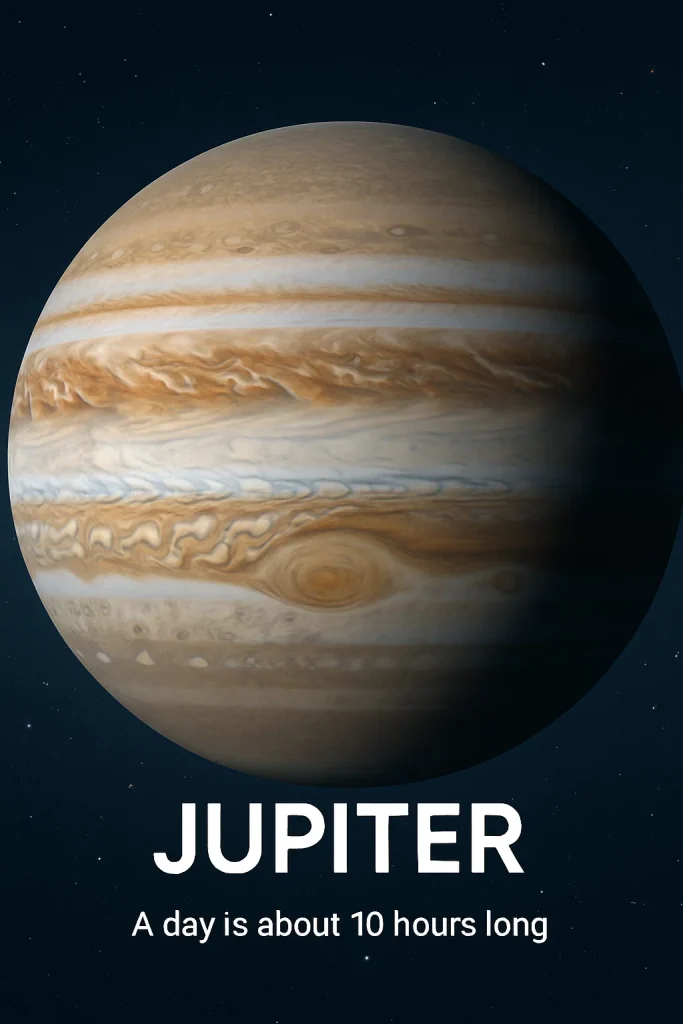⏲️ Estimated reading time: 6 min
🚀 What Would Happen If You Flew a Rocket Straight Through Jupiter? Jupiter is a giant of mystery an enormous planet made mostly of gas and extreme forces. But what if you tried to fly a rocket straight through its middle? This in-depth article explores the physics, dangers, and reality of such a journey.
Human curiosity often pushes us to imagine the impossible. One fascinating thought experiment is asking: what would happen if we tried to fly a rocket through the center of Jupiter, the largest planet in our Solar System?
At first glance, the idea may sound like drilling a tunnel through a planet. On Earth, you could theoretically imagine digging straight down to the other side (though that too is impossible with current technology). But Jupiter is not like Earth at all. It is a gas giant: a world without a solid surface, composed primarily of hydrogen and helium, and dominated by crushing pressures, extreme temperatures, and exotic states of matter.
In this post, we’ll explore in detail what would actually happen to a rocket attempting this unimaginable journey. Step by step, we’ll travel from Jupiter’s upper atmosphere, through its mysterious layers, down toward its strange core. By the end, you’ll see why crossing Jupiter isn’t just impossible it’s one of the most hostile challenges the universe could offer.
Jupiter at a Glance
Before diving in, let’s understand the planet itself:
- Diameter: About 142,000 km (11 times Earth’s diameter)
- Mass: More than 300 times that of Earth
- Composition: About 90% hydrogen, 10% helium, plus trace amounts of other gases
- Surface: No true solid surface, only layers of gas becoming denser with depth
- Magnetic field: Enormous, the strongest in the Solar System, trapping deadly radiation
- Atmosphere: Features colossal storms, such as the Great Red Spot, which has raged for centuries
Jupiter is essentially a massive ball of gas and liquid, with pressures and temperatures so extreme they create metallic hydrogen deep within. That means any rocket daring to enter would face environments unlike anything on Earth.
Step 1: Entering the Clouds
Imagine a rocket entering Jupiter’s upper atmosphere. The first layer looks somewhat familiar: swirling clouds of ammonia and other compounds, colored white, orange, and red. But the resemblance to Earth ends quickly.
- Friction and Heat: Entering at orbital speed would generate tremendous friction. The rocket would face temperatures hot enough to melt its hull.
- Winds and Storms: Jupiter’s winds reach over 600 km/h. Add in powerful lightning storms and turbulence, and the rocket would be violently shaken.
- Radiation: Jupiter’s magnetic field traps enormous amounts of charged particles. Radiation levels here are hundreds of times higher than near Earth’s Van Allen belts, enough to fry electronics and kill astronauts within hours.
At this point, a real rocket would almost certainly be destroyed. But let’s assume, for the sake of the thought experiment, that the rocket is indestructible.

Step 2: Deeper into the Atmosphere
As the rocket pushes further down:
- Pressure Increases: With each kilometer, atmospheric pressure rises rapidly. At depths where sunlight cannot reach, pressure exceeds anything found in Earth’s oceans.
- Temperature Rises: Temperatures soar to thousands of kelvins, hot enough to vaporize most metals.
- Gas Becomes Fluid: Jupiter’s hydrogen turns into a supercritical fluid neither gas nor liquid, but a strange hybrid with unique properties.
By this stage, the rocket is no longer flying through “air” as we understand it, but plunging through a crushing ocean of fluid hydrogen.
Step 3: The Metallic Hydrogen Layer
One of Jupiter’s most fascinating mysteries lies deep inside: metallic hydrogen. Under extreme pressures, hydrogen atoms are squeezed so tightly that their electrons flow freely, turning hydrogen into a conductor like metal.
- Conductivity: This metallic hydrogen is what generates Jupiter’s powerful magnetic field.
- Density: It behaves like a liquid metal, immensely dense and heavy.
- Forces: Any rocket here would be subjected to unimaginable crushing forces.
Crossing this layer would be impossible with real technology. Even our strongest materials would collapse long before reaching it.
Step 4: Approaching the Core
Does Jupiter have a solid core? Scientists are still debating. Data from NASA’s Juno mission suggests Jupiter’s core is “fuzzy” possibly a mixture of rock, ice, and heavy elements, spread out rather than a solid ball.
- Pressure: Tens of millions of times Earth’s atmospheric pressure.
- Temperature: Tens of thousands of kelvins, hotter than the surface of the Sun.
- State of Matter: Unknown but likely a strange mix of elements unlike anything on Earth.
If your rocket could somehow survive this descent, it would not find a floor to land on. Instead, it would sink into this diffused, hot, and pressurized interior.
Step 5: Why You Can’t Come Out the Other Side
In theory, if Jupiter were hollow and you drilled a vacuum tunnel through it, you could imagine falling in one side and emerging on the other, oscillating back and forth like a pendulum under gravity.
But in reality:
- Drag Stops You: The thick fluids create massive resistance. The rocket would lose all kinetic energy and come to a halt at some depth.
- Heat and Pressure: These conditions would destroy any engines or electronics.
- No Tunnel Exists: Jupiter is entirely filled with dense matter; there’s no path through.
Simply put, the rocket wouldn’t come out on the other side. It would be swallowed by Jupiter’s immense bulk.

Why This Matters for Science
Though the idea is impossible in practice, exploring these questions helps scientists think about:
- The behavior of matter under extreme conditions
- How giant planets form and evolve
- What exoplanets similar to Jupiter might be like
- The limits of human technology and materials
NASA’s Juno mission is already teaching us much about Jupiter’s interior by measuring its gravity field and magnetic field. Thought experiments like this one highlight just how alien and extreme Jupiter truly is.
Final Thoughts
So, what would happen if you flew a rocket straight through Jupiter? In reality, the rocket would be:
- Fried by radiation
- Shredded by storms
- Crushed by pressure
- Melted by heat
And even if it were indestructible, it would eventually stop moving, trapped in a sea of metallic hydrogen and dense fluid, never reaching the other side.
Jupiter isn’t a planet you can “pierce.” It’s an enormous, swirling ocean of gas and exotic matter a world that humbles our imagination and reminds us of the vast, untamed power of the universe.
🔔For more tutorials like this, consider subscribing to our blog.
📩 Do you have questions or suggestions? Leave a comment or contact us!
🏷️ Tags: Jupiter, space exploration, gas giants, NASA Juno, metallic hydrogen, planetary science, extreme physics, rocket science, Solar System, astronomy
📢 Hashtags: #Jupiter, #SpaceExploration, #RocketScience, #Astronomy, #NASA, #GasGiants, #SolarSystem, #MetallicHydrogen, #PlanetaryScience, #SpaceFacts
Only logged-in users can submit reports.
Discover more from HelpZone
Subscribe to get the latest posts sent to your email.

